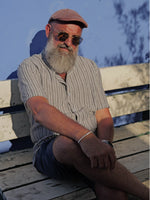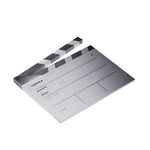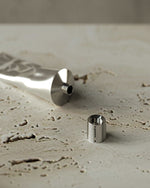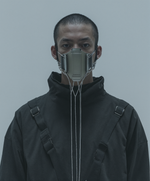20.09.23 in ambassadeurs
antoine ricardou


architect, graphic designer, artistic director, narrative designer… interview with the co-founder of be-pôles, a gifted man with wide-open eyes.
what nourishes you in your profession, what is the source of your inspiration, of the stories that you tell through your creations?
inspiration is a challenge. I notice that many people no longer take the trouble to look for it, contenting themselves with looking at each other, in a reflex that is certainly reassuring but ultimately inbred and much too comfortable. to be strong, we must manage to fit outside of this closed-door system and venture into other territories. literature first of all, it constantly opens new fields for me. a book like zola's l'assosomoir is full of vocabulary points which are playgrounds, certain words - like society - have meanings which allow me to draw new places in my head without having seen a single image . of course, there are also exhibitions, but - in this collective artistic nourishment - you have to manage to search and find the little thing, sometimes tiny, that will touch me. my wife leaving the national school of gardens and landscapes of versailles. my last territory is nature. I am particularly contemplative in difficulty, so I make sure to put myself in a situation that shakes me up, this generates in me a kind of positive nervousness which then makes me want to produce.
who are the people or artists who constitute references for you?
it evolves over time. in pictorial artists, I would say cy twombly. I have images in my head from a book - a house is not a home by bruce weber - we see cy twombly's house, hanging on the cliff, we really feel the fusion between the artist, this place, his art ; everything is confused to such an extent that we don't know which is the genesis of the other. Closer to my work world, there is the illustrator René Gruau whose imagery for Dior we know so well. He's my maternal grandmother's brother, people told me about him when I was younger. I discovered late the extent of his production, so impressive by his characteristic signature. he nourished my universe with the strength of his line and his sense of color.
What compliment means the most to you in your job?
to be told that you have the feeling that a place or a brand that I have supported has been there for 100 years. I am for the permanence of things, I am anti-fashion. I say this with a lot of respect for fashion and for trends that bring completely necessary energy. I simply chose to focus on the foundations.
the city or destination that inspires you or resembles you?
if it wasn't Paris. then, I would say Chamonix. because I feel surrounded by stories, I have the feeling of experiencing the literature of the mountains, of being at the heart of the adventure. it's incredible to look at the peaks when you're at the bottom of the valley. it is a city so full of stories, a powerful place, it looks like a city drawn at the bottom of the Mariana Trenches and which looks up to the light, the exit. but all the same, I would also have liked to be able to answer Paris, I continue to be amazed by the beauty of this city, by its stacked strata which make it what it is, by the trees which have been there for centuries. When I ride my bike there, I admit that I sometimes feel like a knight on my horse because this city is so intoxicating with history.
what nourishes you in your profession, what is the source of your inspiration, of the stories that you tell through your creations?
inspiration is a challenge. I notice that many people no longer take the trouble to look for it, contenting themselves with looking at each other, in a reflex that is certainly reassuring but ultimately inbred and much too comfortable. to be strong, we must manage to fit outside of this closed-door system and venture into other territories. literature first of all, it constantly opens new fields for me. a book like zola's l'assosomoir is full of vocabulary points which are playgrounds, certain words - like society - have meanings which allow me to draw new places in my head without having seen a single image . of course, there are also exhibitions, but - in this collective artistic nourishment - you have to manage to search and find the little thing, sometimes tiny, that will touch me. my wife leaving the national school of gardens and landscapes of versailles. my last territory is nature. I am particularly contemplative in difficulty, so I make sure to put myself in a situation that shakes me up, this generates in me a kind of positive nervousness which then makes me want to produce.
who are the people or artists who constitute references for you?
it evolves over time. in pictorial artists, I would say cy twombly. I have images in my head from a book - a house is not a home by bruce weber - we see cy twombly's house, hanging on the cliff, we really feel the fusion between the artist, this place, his art ; everything is confused to such an extent that we don't know which is the genesis of the other. Closer to my work world, there is the illustrator René Gruau whose imagery for Dior we know so well. He's my maternal grandmother's brother, people told me about him when I was younger. I discovered late the extent of his production, so impressive by his characteristic signature. he nourished my universe with the strength of his line and his sense of color.
What compliment means the most to you in your job?
to be told that you have the feeling that a place or a brand that I have supported has been there for 100 years. I am for the permanence of things, I am anti-fashion. I say this with a lot of respect for fashion and for trends that bring completely necessary energy. I simply chose to focus on the foundations.
the city or destination that inspires you or resembles you?
if it wasn't Paris. then, I would say Chamonix. because I feel surrounded by stories, I have the feeling of experiencing the literature of the mountains, of being at the heart of the adventure. it's incredible to look at the peaks when you're at the bottom of the valley. it is a city so full of stories, a powerful place, it looks like a city drawn at the bottom of the Mariana Trenches and which looks up to the light, the exit. but all the same, I would also have liked to be able to answer Paris, I continue to be amazed by the beauty of this city, by its stacked strata which make it what it is, by the trees which have been there for centuries. When I ride my bike there, I admit that I sometimes feel like a knight on my horse because this city is so intoxicating with history.
“Inspiration is a challenge. I notice that many people no longer take the trouble to look for it, contenting themselves with looking at each other, in a reflex that is certainly reassuring but ultimately inbred and much too comfortable. »

how would you define your way of being and living?
I make sure it is as natural as possible, in the sense that I don't want it to be scripted. it's the condition of wonder, I never want to feel jaded. I therefore live with my eyes wide open, in search of inspiration, of a form of marvel that can be found in everything. we must keep this part of childhood which allows us to touch the extraordinary. When I take a plane, I try to return to the childhood state I was in the first time I took off, to this form of candor and disbelief.
your favorite themes in your creative approach?
color to begin with is a constant search, as evidenced by the work of delaunay or josef albers which always inspires me. typography too, helvetica is a theme in its own right, as are the serif typographies of the 18th century. I would also say the poverty of means, I find that it is a formidable constraint to start with little to ultimately generate a lot of energy. finally and this is certainly the most important for me, there is functionalism, the idea of working only with a will always linking form and function. zero decoration.
your reference visual identity? or the one you would have loved to do, and the one you would like to do?
in fashion, for me the strongest construction is hermès, in all that that entails. because the notion of identity goes beyond the visual universe. so at Hermès there is total consistency from the logo to the stitching and the fold of leather. each touchpoint is a brand experience in its own right. I would have liked to work with aésop, its founder is someone who inspires me a lot. they have this unique way of living with architecture, they have dared to free themselves from systems by refusing declinability at all costs. I would have loved to be at the origin of a project like this which is as much architectural as it is graphic.
your favorite graphic form?
my form is a homothety of the din format (deutsches institut für normung) generated from the ratio that is the golden ratio. I always start from this grid of formats. we therefore always come back to this notion of functionalism, to this need to associate form with function.
your biggest challenge achieved or to be achieved as a graphic designer?
I spoke about it previously, it is already a daily challenge not to fall into fashion.
your ritual in your job(s)?
sport and drawing: at the same level. Sport allows me to process a huge amount of thoughts, I forget or I memorize. I can't explain the mechanics, let's say that the elements are registered somewhere, they will be triggered at a certain moment, it's my way of sorting and structuring the data. one of my teachers told me: “an architect is an eye and a line”. you have to know how to look but also transcribe things. stop and look through the prism of drawing. it's my way of integrating what's around me, I know that if I stop and draw something then I will remember it for the rest of my life.
I make sure it is as natural as possible, in the sense that I don't want it to be scripted. it's the condition of wonder, I never want to feel jaded. I therefore live with my eyes wide open, in search of inspiration, of a form of marvel that can be found in everything. we must keep this part of childhood which allows us to touch the extraordinary. When I take a plane, I try to return to the childhood state I was in the first time I took off, to this form of candor and disbelief.
your favorite themes in your creative approach?
color to begin with is a constant search, as evidenced by the work of delaunay or josef albers which always inspires me. typography too, helvetica is a theme in its own right, as are the serif typographies of the 18th century. I would also say the poverty of means, I find that it is a formidable constraint to start with little to ultimately generate a lot of energy. finally and this is certainly the most important for me, there is functionalism, the idea of working only with a will always linking form and function. zero decoration.
your reference visual identity? or the one you would have loved to do, and the one you would like to do?
in fashion, for me the strongest construction is hermès, in all that that entails. because the notion of identity goes beyond the visual universe. so at Hermès there is total consistency from the logo to the stitching and the fold of leather. each touchpoint is a brand experience in its own right. I would have liked to work with aésop, its founder is someone who inspires me a lot. they have this unique way of living with architecture, they have dared to free themselves from systems by refusing declinability at all costs. I would have loved to be at the origin of a project like this which is as much architectural as it is graphic.
your favorite graphic form?
my form is a homothety of the din format (deutsches institut für normung) generated from the ratio that is the golden ratio. I always start from this grid of formats. we therefore always come back to this notion of functionalism, to this need to associate form with function.
your biggest challenge achieved or to be achieved as a graphic designer?
I spoke about it previously, it is already a daily challenge not to fall into fashion.
your ritual in your job(s)?
sport and drawing: at the same level. Sport allows me to process a huge amount of thoughts, I forget or I memorize. I can't explain the mechanics, let's say that the elements are registered somewhere, they will be triggered at a certain moment, it's my way of sorting and structuring the data. one of my teachers told me: “an architect is an eye and a line”. you have to know how to look but also transcribe things. stop and look through the prism of drawing. it's my way of integrating what's around me, I know that if I stop and draw something then I will remember it for the rest of my life.
“I would also say the poverty of means, I find that it is a formidable constraint to start with little to ultimately generate a lot of energy. »
the graphic design that annoys you?
the one who is fashionable, obviously. the student portfolios which follow one another identically. we come back to this sort of collective algorithm which governs everything, this mise en abyme of graphic designers looking at graphic designers, looking at other graphic designers…
you trained as an architect, you ultimately became a reference in graphic design, what other job would you have liked to do?
zinc worker on the roofs of Paris, to be able to climb to the top of buildings, to have the right to build a cabin above the roofs, to have a picnic while looking at Paris, to be on the summit permanently.
a favorite place to usually find yourself?
on a roof precisely. in the 9th at be-pôles, in montmartre at home… I need to be at the top, this allows me to choose if I want to go down or not.
your favorite object? how much does he weigh ?
I have two, a slightly oily 5b pencil and a moleskine a6 b6 notebook. I've been numbering my notebooks almost forever, I'm at number 118.
what has weight in your life?
my wife, my children, my family.
your object(s) on le gramme, what is/are they? how do you use the doors?
I have the 43g ruler that I use all the time, it's on my desk, I roll it mechanically often... I also have a 23g brushed pyramid guilloche bracelet that I admit I don't wear all the time, I realize that I erase the points of sophistication over time.
what is your relationship to the object?
that’s a great question. I would say that it is even a fascination. It’s certainly not the ostentation that attracts me and even less the effect. it’s the function of everything that touches me. when it is used well and the gesture with it becomes perfect then the harmony is evident. It’s touching how an “ugly” object can become sublime in a context of work or use. this ruler on my desk, I looked at it in every detail and I find it perfect. but it is when I trace with him that he reveals himself much more extraordinary. the plus is the function of the object.
If you could give a new shape to le gramme, what would it be?
le gramme is eminently solid, precious, raw. I would like to change its molecular structure to make it a liquid, just as precious as a perfume, in milliliters.
the one who is fashionable, obviously. the student portfolios which follow one another identically. we come back to this sort of collective algorithm which governs everything, this mise en abyme of graphic designers looking at graphic designers, looking at other graphic designers…
you trained as an architect, you ultimately became a reference in graphic design, what other job would you have liked to do?
zinc worker on the roofs of Paris, to be able to climb to the top of buildings, to have the right to build a cabin above the roofs, to have a picnic while looking at Paris, to be on the summit permanently.
a favorite place to usually find yourself?
on a roof precisely. in the 9th at be-pôles, in montmartre at home… I need to be at the top, this allows me to choose if I want to go down or not.
your favorite object? how much does he weigh ?
I have two, a slightly oily 5b pencil and a moleskine a6 b6 notebook. I've been numbering my notebooks almost forever, I'm at number 118.
what has weight in your life?
my wife, my children, my family.
your object(s) on le gramme, what is/are they? how do you use the doors?
I have the 43g ruler that I use all the time, it's on my desk, I roll it mechanically often... I also have a 23g brushed pyramid guilloche bracelet that I admit I don't wear all the time, I realize that I erase the points of sophistication over time.
what is your relationship to the object?
that’s a great question. I would say that it is even a fascination. It’s certainly not the ostentation that attracts me and even less the effect. it’s the function of everything that touches me. when it is used well and the gesture with it becomes perfect then the harmony is evident. It’s touching how an “ugly” object can become sublime in a context of work or use. this ruler on my desk, I looked at it in every detail and I find it perfect. but it is when I trace with him that he reveals himself much more extraordinary. the plus is the function of the object.
If you could give a new shape to le gramme, what would it be?
le gramme is eminently solid, precious, raw. I would like to change its molecular structure to make it a liquid, just as precious as a perfume, in milliliters.
“that’s a great question. I would say that it is even a fascination. It’s certainly not the ostentation that attracts me and even less the effect. »
---accumulation---
bracelet_23g_silver-925_polished_guilloche-pyramid_ribbon;reglet_43g_silver-925_polished_smooth






